History of Royal Palace of Naples In A Nutshell
Nestled in the heart of Naples, the Royal Palace stands as a witness to centuries of Italian history. Built in the 17th century for Spanish viceroys, its architecture blends Renaissance, Baroque, and Neoclassical styles. This opulent palace symbolizes Neapolitan culture and heritage.
During the Bourbon dynasty's reign in the 18th and 19th centuries, led by King Charles III, Naples became a cultural capital, attracting luminaries like Goethe and Mozart. The palace thrived as the center of court life and intellectual exchange.
In the 19th-century Italian Unification movement, the Royal Palace played a pivotal role. It became a stronghold for revolutionary activities and a meeting point for figures striving for Italian unity.
Adding to its allure are lesser-known stories, like hidden underground tunnels connecting the palace to Castel dell'Ovo, offering secret escape routes for the nobility during unrest. This blend of history and mystery makes the Royal Palace of Naples an enchanting testament to the past, preserving Italy's cultural heritage.
Bourbon Family
The influence of the Bourbon family in Naples during the 18th and 19th centuries was transformative, elevating the city into a cultural capital of Europe. Under the enlightened rule of King Charles III and his successors, Naples flourished as a vibrant center of arts, literature, and music. The Bourbon Court attracted renowned luminaries such as Goethe and Mozart, who contributed to Naples' cultural prominence.
The royal patronage and support for the arts resulted in the establishment of numerous cultural institutions, theaters, and academies. The city became a hub for intellectual exchange and artistic expression. The Bourbon monarchs' focus on urban development and architectural projects enhanced the city's allure.
Their progressive policies also encouraged the spread of education and learning, leading to a thriving intellectual and creative atmosphere. As a result, Naples emerged as a distinguished cultural capital that left an enduring impact on European art and society.















